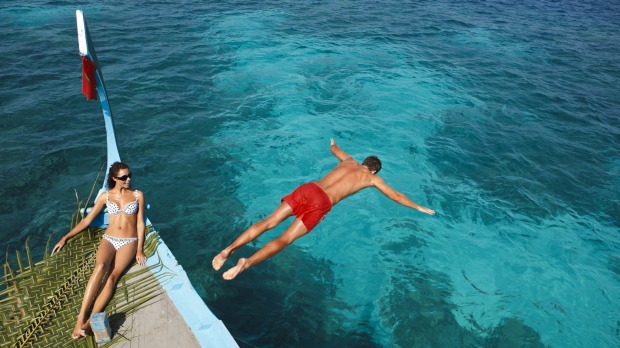
"Don't pee … hold it in." It's the only advice my guide Teddie is giving, even though this will be my first ever night snorkel; and my first ever night snorkel with sharks. "They get excited by urine," Teddie says, his toothy smile in the encroaching dusk all I can make out of his features. He's loving this, I don't need to see his face to know that. "Or so they say," he keeps talking. "I just don't do it because I don't want to find out it's true when a shark bites me on the crotch."
Encouraging, Teddie … very encouraging. I'm spitting into my goggles to stop them fogging underwater as I balance on the edge of our tender: I don't know why, but I'd like to see the shark that bites me. Beside me a dorsal fin sluices up the mirrored Maldivian water.
We're offshore from the aquatic island resort of Alimatha where staff feed large nurse sharks each day at sunset to offer guests a living, breathing nature extravaganza. Teddie's idea – because he says we can do whatever we want on this boat cruise – is that we'll enter the water near the shark feeding zone for a close encounter with three-metre-long-and-beyond nurse sharks.
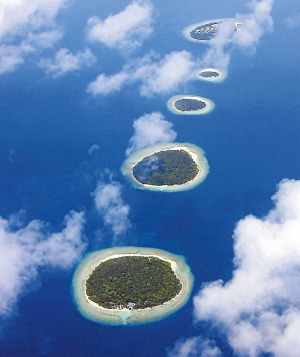
Which sounded like a bloody good idea at lunchtime, perched as I was, beer in hand, on the top deck of my very own dhoni boat, master of my own destiny, fearer of no foe, a bronzed pirate of the Indian Ocean. Now, with stars already twinkling in the black sky above, the plan doesn't seem so grand. But Teddie assures me he's lost no limbs, or extremities. I count them … he's telling the truth. He hands me a torch, reminds me again to "hold it in", and we ease into the water… slowly, so as not to make too big a splash.
The sea induces a claustrophobic tightness at night: I feel the dark water close in around me. Even with two torch beams projecting a path through the darkness, I can barely see a thing. Till the first shark, that is. I catch the glint of its eyes in my torch beam, and its mouth puckered up into a snarly smile. It's big: 2½ metres at least, and it moves quickly; stealth like, like a missile. Then there's another monster. And another, as big as the first; or bigger? We swim in closer to the resort's jetty, and there's another five here, some three metres long. And there's sting rays too, darting back and forth, adding to the chaos. I'm breathing so fast I can hear the carbon dioxide echoing around the cheap plastic walls of my snorkel. I'm terrified, but mesmerised; completely at the mercy of the ocean and its creatures.
Eventually, we swim back to the boat, and under a billion blinking stars I lay stretched out on the tender, sucking in the warm night air, elated to be breathing it at all; but as high as a kite on the fumes of unscripted adventure.
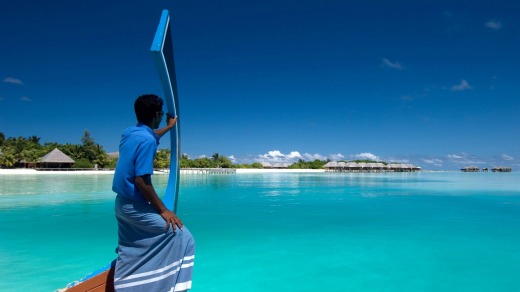
But then, isn't this the way you should approach the Maldives? On the back of a tiny, traditional dhoni, with an itinerary that can be changed to suit, depending on where the creatures of the sea that make the Maldives famous are likely to be. This is an island nation that's 99 percent ocean, after all. There might well be 1192 islands set across 90,000 square kilometres of Indian Ocean, but the tallest point on any island is a barely-higher-than-you-or-me 2.3 metres high, while even the larger islands in the group still barely measure more than a square kilometre. In the Maldives the sea is the hero – islands are part of live coral reefs and sandbars perched on top of a 960-kilometre submarine ridge. And there's no better way to pay homage to all that lies beneath than on a dhoni, with mask and snorkel at the ready.
And for the price of a night in the five-star over-water bungalows around me, I'll be motoring my way slowly round these islands for almost a week. I'll have a local crew on hand to cook – including food we catch ourselves – and a local guide who'll consult us daily to determine what we'd like to do, and how far we'd like to detour from the set path.
This is a rare kind of adventure: one with just enough creature comforts to please the fussiest traveller, but with none of the waiver forms, the safety barriers and the enforced restrictions that typify so much modern travel.
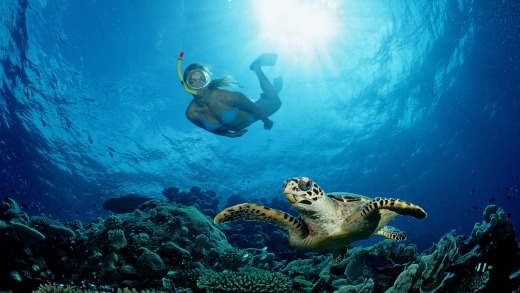
On my first morning on the dhoni – after I land at Male's international airport and I'm taken by tender from a harbour just 100 metres from the airport – I ask Teddy if it's OK to jump into the water from the boat's top deck. "Of course," he says, looking confused by my question. "But why don't you do a backflip?"
Later that afternoon Teddie sinks seven metres without warning to the ocean floor to fetch a huge octopus he spots amongst the coral. It attaches itself to his arms and I watch as he struggles with it all the way up to the surface, where he's brought it just to show me a "real octopus up close".
But this isn't just a boy's-own adventure trip, though in its most exciting moments, it sure feels that way. Like most visitors to these islands, most guests on board are couples, with a program to suit the most adventurous to the non-adventurous.
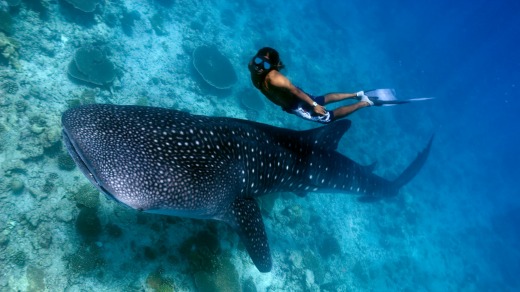
After days on board steaming between far-flung atolls and reefs and snorkelling the parallel universe under the sea, I realise I don't need to be entertained on my vacation. If you watch the sea long enough from the top deck something will always happen. Each time I try to read, I'm interrupted by another splash: a breaching turtle, a leaping dolphin, or schools of fish running across the water, chased by God knows what. Even at anchor I struggle to read a single word, mesmerised instead by a big shape chasing a silver rush of tiny bait fish.
The Maldives are home to some of the world's most exotic sea creatures, (including whale sharks). There's 12 species of whales and dolphins alone in residence here, and it's not unusual to see single pods of dolphins measuring 200 or more.
We visit inhabited islands – walking through traditional local communities, glimpsing life for these unlikely seafarers in their hefty, heavy Islamic robes. But mostly I prefer to escape civilisation altogether, and find an empty atoll of my own, and watch the light ease out of each day. It's these gentle moments of dusk that I treasure most – they're when I realise the dhoni has become my whole world. I like the sense of security that comes in shrinking my existence down to these sturdy slabs of timber on a rippleless ocean.
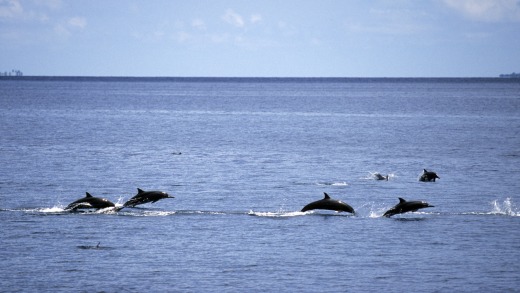
I find I'm dead tired each night after dinner – after a day spent under water, or in the ever-present Maldivian sunshine, so some nights I retire to a mattress under the stars on the top deck early and don't rise again till dawn, when I'm woken by sunrise and a cup of steaming hot tea brought to me by a deck hand who understands my routine.
Life at sea follows no rigid time-frame, activities seem to revolve around the sun and when it comes up and goes down; it's always what I've preferred about travel that leaves the shore behind. We float like this for six days, anchoring off tiny uninhabited islands, spotting no other tourists at all but a handful of surfers scratching their way across remote reef passes. The world I knew seems far behind me, here it's just us and the animals that lurk below the dhoni, luring us to swim. And so it's with quite a shock that just as quickly as I left it behind, I'm deposited by tender to Male's international airport and I join the throngs of travellers I left far behind in my very private voyage across the Maldives.
visitmaldives.com
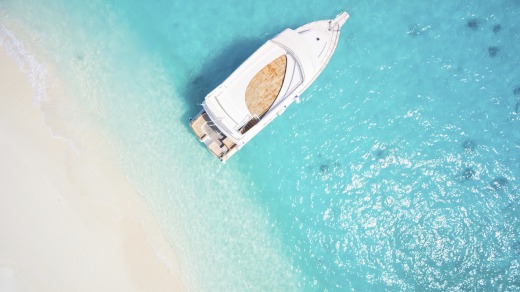
Singapore Airlines flies daily to Male via Singapore, see singaporeair.com
World Expeditions six-day Maldives Dhoni Cruise departs year round and costs $1550 per person (there is a $140 high-season surcharge between December 20 and April 21, and during August). See worldexpeditions.com